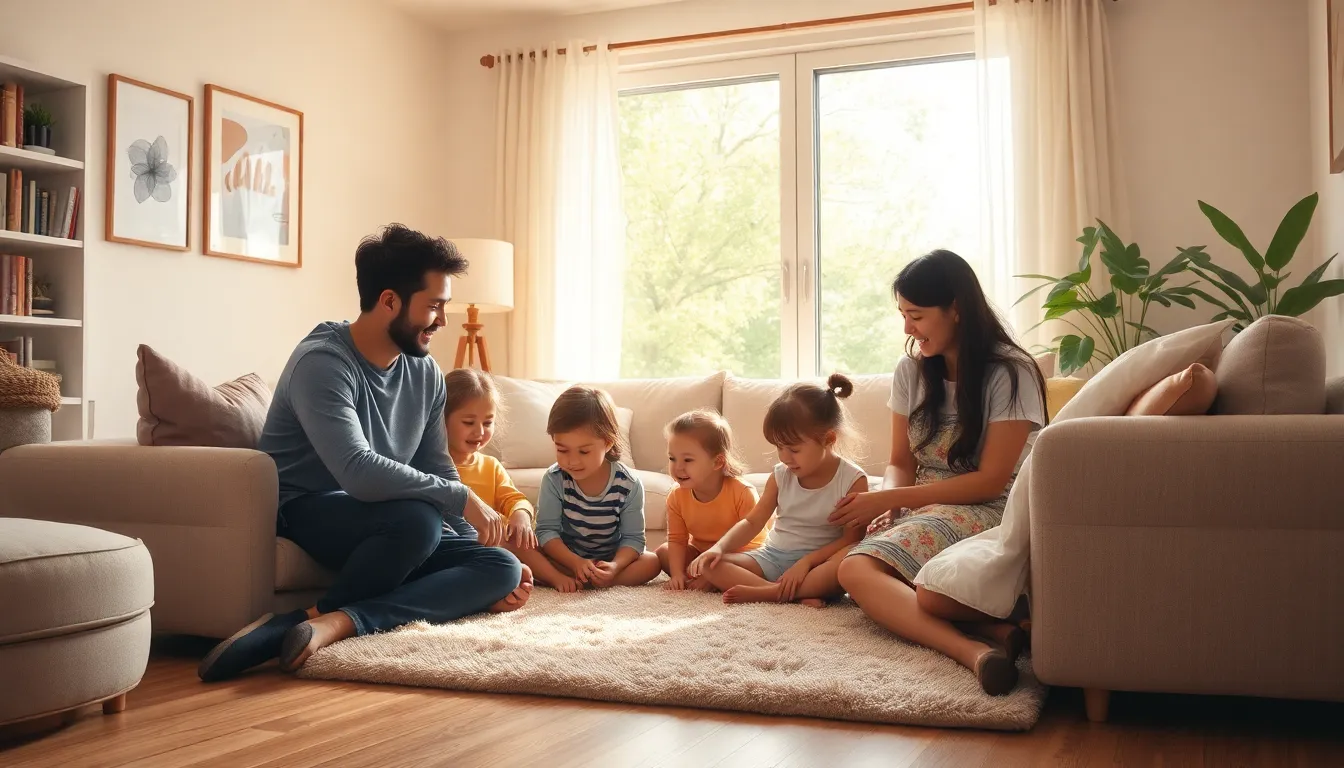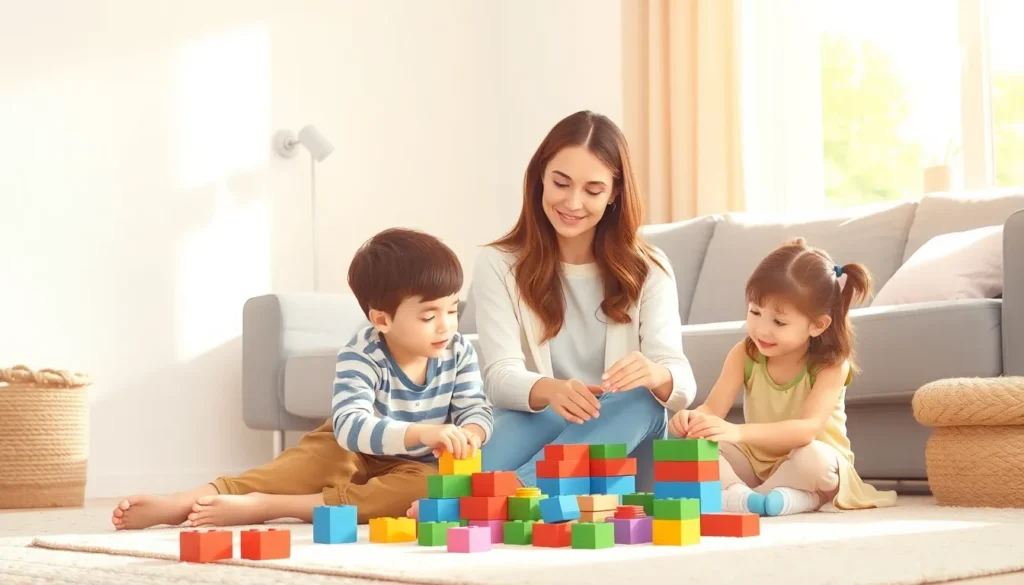Table of Contents
ToggleIn a world where chaos reigns supreme, calm parenting emerges as a refreshing oasis. Imagine navigating the wild ride of parenthood without losing your cool or resorting to interpretive dance in the grocery aisle. It’s not just a dream; it’s a strategy that empowers parents to embrace the madness with grace and humor.
Calm parenting isn’t about being a robot or suppressing emotions. It’s about cultivating a peaceful environment where kids can thrive and parents can keep their sanity intact. With a sprinkle of patience and a dash of mindfulness, parents can transform their daily interactions into moments of connection rather than conflict. So buckle up and get ready to discover how calm parenting can turn your household from a circus into a serene sanctuary.
Understanding Calm Parenting
Calm parenting emphasizes a peaceful, nurturing environment that benefits both children and parents. This approach focuses on patience and mindfulness, allowing for more meaningful connections.
Definition of Calm Parenting
Calm parenting refers to a style that prioritizes emotional regulation and kindness over frustration and anger. It encourages caregivers to respond thoughtfully rather than reactively. This method fosters a supportive atmosphere where children feel safe expressing themselves. Engaging with children calmly promotes healthy emotional development, allowing them to learn coping skills.
Importance of Calm Parenting
Importance lies in its potential to transform family dynamics. Establishing a calm environment reduces stress and anxiety for both parents and children. As parents model emotional regulation, children can develop their own skills for managing feelings. Calm interactions create stronger bonds, enhancing communication and trust. Overall, prioritizing a serene household paves the way for positive behavior and emotional resilience in children.
Benefits of Calm Parenting

Calm parenting offers numerous advantages for both parents and children. By fostering a peaceful atmosphere, families can experience greater harmony and understanding.
Emotional Well-Being for Parents
Emotional well-being for parents improves significantly with calm parenting practices. Higher levels of patience often decrease feelings of frustration. Parents find themselves equipped to handle challenging moments with grace, leading to reduced stress and anxiety. Prioritizing mindfulness allows caregivers to connect with their emotions, enhancing their ability to provide support. Calm interactions create a nurturing environment that promotes parental satisfaction and happiness. This approach helps parents model emotional regulation, which in turn cultivates personal resilience.
Positive Impact on Children
Children benefit from the positive environment fostered by calm parenting styles. Enhanced emotional development occurs as children feel safe expressing their feelings. Stronger connections with caregivers contribute to their overall well-being. The approach promotes healthy coping skills and encourages children to engage in problem-solving. Children exposed to calm and supportive responses learn to manage their own emotions more effectively. Developing trust between parents and children fosters open communication, which strengthens family bonds over time.
Techniques for Practicing Calm Parenting
Practicing calm parenting involves various techniques that can foster a serene environment. By implementing these strategies, parents can create positive interactions with their children.
Mindfulness Strategies
Mindfulness enhances emotional regulation. Engaging in deep breathing exercises can provide immediate stress relief during challenging moments. Parents can practice present-moment awareness by observing their thoughts and feelings without judgment. Journaling daily experiences also promotes self-reflection. Creating a routine that includes moments of stillness allows parents to recharge. Incorporating mindfulness activities, such as yoga or meditation, into family time encourages bonding. These practices help cultivate patience. By embracing mindfulness, parents can model emotional awareness for their children.
Effective Communication Skills
Effective communication forms the backbone of calm parenting. Listening actively fosters trust and understanding. Using open-ended questions encourages children to express their thoughts and feelings freely. Parents can practice validating emotions by acknowledging their child’s feelings without judgment. Setting aside dedicated time for conversations strengthens connections. Utilizing “I” statements helps convey feelings without placing blame. By maintaining a calm tone, parents reinforce a secure atmosphere. Strong communication skills empower children to articulate their needs, promoting healthy relationships within the family.
Challenges in Calm Parenting
Calm parenting presents several challenges that can test even the most patient caregivers. Managing emotions and maintaining tranquility during difficult moments can be tough.
Common Obstacles
Everyday stressors often disrupt calm parenting efforts. Common obstacles include time constraints, unrealistic expectations, and external pressures. Parents face demands from work, home, and social obligations, leading to heightened stress. Interruptions, such as sibling fights or tantrums, further complicate nurturing a peaceful environment. Additionally, societal norms sometimes promote reactive parenting styles, making calm responses seem counterintuitive. Recognizing these hurdles is essential for developing strategies that promote calmness amidst chaos.
Overcoming Stressful Situations
Navigating stressful situations demands effective strategies to maintain calm. One approach involves practicing mindfulness techniques, such as taking deep breaths or counting to ten before responding. Utilizing positive self-talk reinforces the commitment to calmness. Engaging in family activities can also create connections, fostering a supportive atmosphere. Clear communication about feelings and expectations helps prevent misunderstandings. Setting realistic goals for oneself and the family further eases stress. Prioritizing self-care through regular breaks strengthens emotional resilience, allowing parents to approach challenges with patience and understanding.
Embracing calm parenting can lead to transformative changes in family dynamics. By prioritizing emotional regulation and fostering a supportive environment, parents can cultivate stronger bonds with their children. This approach not only enhances the emotional well-being of both parents and kids but also promotes healthy coping skills and open communication.
While challenges may arise, the journey toward a serene household is achievable through mindfulness and effective communication strategies. With commitment and practice, calm parenting can create lasting positive effects that resonate throughout the family. Ultimately, nurturing a peaceful atmosphere paves the way for emotional resilience and a harmonious home life.







